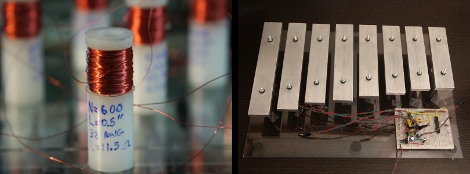Learn to manufacture your own solenoids and then use them to play the xylophone by watching the tutorial video after the break. [Humberto Evans] and the team at Nerd Kits do a great job of not only manufacturing the coils, but the xylophone itself. The bars are machined from some aluminum stock and they take you down the rabbit hole with they why’s and how’s of engineering the keys.
We’re unlikely to replicate this machining process but the solenoids are another story all together. Starting at about 3:30 you can learn about designing, building, and using these little marvels. They’re basically an electromagnetic cuff with a metal slug in the middle. The solenoid seen above uses a body milled from HDPE and wrapped with magnet wire. The slug in the center is steel, with a few rare-earth magnets at the top. When you run current through the coil it repulses the magnets on the slug, witch then strikes the xylophone key. Using a MOSFET and a protection diode, actuating them is as simple as sending a digital high from your microcontroller of choice.
We’ve seen solenoids used to play a vibrophone before, but those were commercial units. Making your own hardware is far more hardcore.
















Which witch? The they? Get an editor.
Nice project!
Yeah it’s pretty embarrassing how bad some of the writers’ grammar is.
That said, cool link. That would be a neat job.
it’s good that they went to basics on this but i think it would sound louder if they just used regular solenoids
they’re also stiking the bar with a flat surface, maybe they could put a little round hard rubber piece over the magnet
+1 for theory of sound, that is the best book ever
Not bad but the video could be shorter by approximately 12 minutes 30 seconds.
The power supply circuit is interesting too. Since firing solenoids draw a ton of current causing constant voltage spikes/drops, they use a diode+capacitor before the 9 V -> 5 V regulator. However, I think the calculation of 15 ms power reserve are not correct since it doesn’t account for the ~1 V voltage drop across the diode. It’s interesting that they used LEDs as flyback diodes across the MOSFETs driving the solenoids.
I really like how the go through all the details… even though it is a lot of details.
I think it’s interesting that some notes have a much fuller sound to them and some seem to be severely damped – are the screws too tight or is it something else?
@David S: My guess is that the microphone used in the recording is coloring the sound; the mids sound much better than the highs do.
There’s too much damping of the bars, especially given the limited momentum of the solenoid slug. I would be inclined to have the bar cantilevered with only one support, like a tine in an old electric piano. The solenoid design is really creative, though.
I used to work in a company that makes digital looms that copy patterns from a 486 computer, by using some solenoids parts that were just cut coils from relays to move individual treads up/down. The relay was put in a vice and then cut in 2 parts with a metal saw. Since then I’ve been playing with such coils at home also. It’s so practical since the coils were already rated to certain voltage, so I know what I’m getting into…
That really is quite cool.
The kind of thing that makes you want to think up applications, and why this site is dear to me.
Yeah I said it, ya big lugs…
Nice job.
BTW, a xylophone is made of wood (Greek ξύλον – xylon = wood). This would be a vibraphone.
whether it is a xylophone/vibraphone doesn’t change the physics / concepts depicted in the video — the only difference would be the way the sound.
Great video. I agree with Joe.
What exactly *is* electrical current, anyhow?
It’s neither a xylophone or a vibraphone.
It’s a glockenspiel.
Philippe is correct that a xylophone has wooden bars. However, a vibraphone has a resonating tube for each bar and a rotating valve that produces a tremolo or vibrato effect, hence the name vibraphone. Usually with a pedal to allow the damper to move away from the bar which lets the notes ring much like a sustain pedal on a piano.
Actually, the effect produced on a vibraphone is not vibrato at all (gradual variation in pitch) but a much less used definition of tremolo. This is usually described as a rapid repetition of the same note but can be used to describe amplitude as in this case.
[/pedantic_nitpicking]
The rate of flow of charge, measured in coulombs per second.
I sense that this is not the answer you were looking for however…
So, why don’t we just say “Amperes” then?
Because its the unit, not the name of the quantity?
It would be like calling acceleration, “Meters per second per second”
http://hackaday.com/2010/09/05/self-playing-bayan-built-nearly-22-years-ago/
yeah, english@HAD can be pretty shoddy, and szczys is probably the worst offender.
i guess this is OK [it is a hacking site], but i wonder about the ratio of laziness to incompetence that accounts for such errors…
having poor mastery of language is a little sad. ;[
Its a doorbell, OK, its a fancy, computer controlled doorbell, but its still a doorbell.
Having said that, its a well executed, and well explained doorbell.
http://en.wikipedia.org/wiki/Doorbell
Ahull – so what, let it be a doorbell :)
Anyway, interesting article, good read!
Interesting article. And, yes ahull let it be a doorbell :)
Some of the notes are too quiet and flat.
The solenoids would hit harder if the magnets were on non-ferrous slugs which are fighting the repulsion between the coil fields and the magnets.
It’s a neat project but it’s in the category of reinventing not just the wheel but the entire wagon.